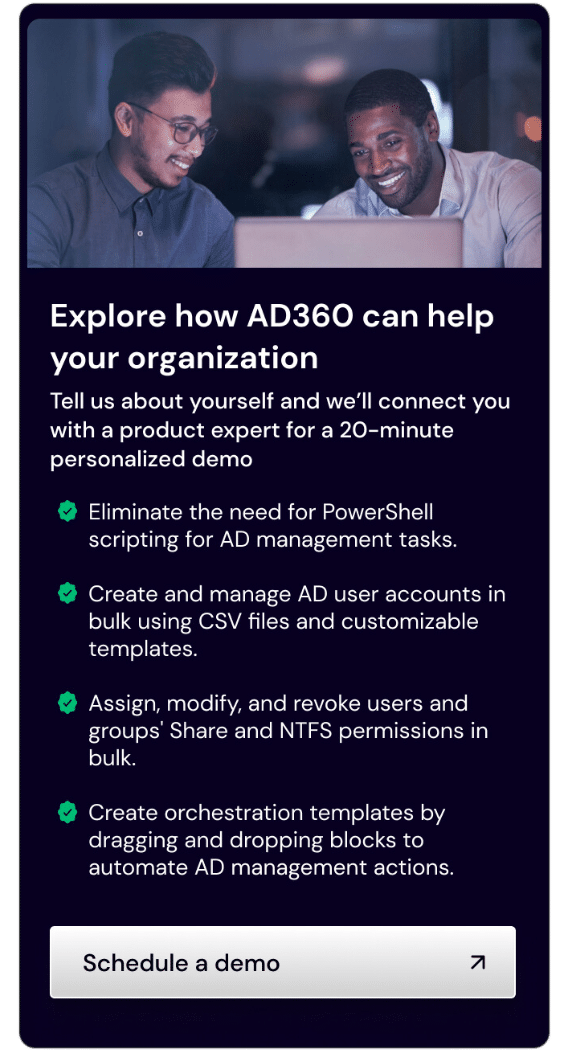
Active Directory · PowerShell automation
Automating OU cleanup in Active Directory with PowerShell: the expert’s comparison guide
A practical, production-oriented approach to discover, stage, delete, and prune—safely.
Short definition for snippets: Automating OU cleanup means discovering stale or misplaced objects, staging them safely, and removing obsolete containers on a schedule—using a reversible PowerShell pipeline with logging and approvals.
Why this matters now
Hybrid identity skews simple “last logon” signals. VPN-less access, cloud apps, and service principals make accounts look active when they’re not. Cleanup automation provides a lean directory and an audit-ready trail without manual toil.
What most teams do—and why it falls short
The classic script finds users with LastLogonDate older than N days, disables them, then moves them to a quarantine OU. After a grace window, it deletes objects and prunes empty OUs. It works, but keep these in mind:
- lastLogonTimestamp lag: replicated infrequently; use it as a screen, not a verdict.
- LastLogonDate is derived: convenient, not exact; verify for high-risk scopes.
- OU deletions fail: protection flags and non-empty OUs block unattended deletes.
First principles to design around
- Signals are probabilistic. Build review and rollback.
- OUs amplify policy. Moving objects changes GPO scope and delegation.
- Safety beats speed. Report → disable+move → delete, with grace and logs.
- Scheduling is part of it. Use explicit PowerShell arguments in Task Scheduler.
Choose your cleanup style: a comparison
Timestamp-driven cleanup (fastest)
Signal: LastLogonDate/lastLogonTimestamp, optionally pwdLastSet and Enabled. Pros: quick and simple. Cons: coarse signals; possible false positives.
Event-correlated cleanup (more accurate)
Signal: timestamps plus sign-in logs (VPN, RADIUS, Entra, workstation events). Pros: fewer mistakes. Cons: more plumbing.
Structural OU hygiene (prevents drift)
Signal: OU age, emptiness, naming standards, GPO lineage. Pros: durable structure. Cons: ongoing governance.
The main technical playbook (copy, adapt, version)
This is the production path: discover → stage → review → enforce → prune. Safe defaults, reversible moves, explicit logs.
0) Requirements
- Windows Server with RSAT / ActiveDirectory module.
- Service account with least-privilege: read tree; write in quarantine OU; delete in a controlled subtree only.
- Neutral quarantine OU with minimal GPOs.
1) Policy inputs
- Inactivity thresholds (e.g., 90 days for users, 45 days for workstations).
- Grace window (e.g., 30 days disabled before deletion).
- Exclusions (Domain Admins, service accounts, break-glass identities).
- Outputs (CSV/JSON logs, ~400-day retention).
2) Discovery: users and computers
Use replicated signals to flag candidates. Scope your search bases to avoid surprises.
Import-Module ActiveDirectory
$now = Get-Date
$userAgeDays = 90
$compAgeDays = 45
$searchBase = "OU=Corp,DC=contoso,DC=com"
$quarantineOU = "OU=Quarantine,OU=Corp,DC=contoso,DC=com"
$cutUser = $now.AddDays(-$userAgeDays)
$cutComp = $now.AddDays(-$compAgeDays)
# Users likely inactive
$staleUsers = Get-ADUser -SearchBase $searchBase -LDAPFilter "(|(objectClass=user)(objectClass=msDS-GroupManagedServiceAccount))" `
-Properties LastLogonDate, lastLogonTimestamp, pwdLastSet, Enabled, MemberOf |
Where-Object {
$_.Enabled -eq $true -and
$_.LastLogonDate -lt $cutUser -and
($_ | Select-Object -ExpandProperty MemberOf) -notmatch "CN=Domain Admins|CN=Service Accounts|CN=BreakGlass"
}
# Computers likely inactive
$staleComputers = Get-ADComputer -SearchBase $searchBase -LDAPFilter "(objectClass=computer)" `
-Properties LastLogonDate, OperatingSystem, Enabled |
Where-Object { $_.Enabled -eq $true -and $_.LastLogonDate -lt $cutComp }Why not lastLogon? It’s per-DC and not replicated. lastLogonTimestamp replicates but lags—use it as advisory.
3) Stage: disable + move (reversible)
Never delete on first pass. Disable and move to quarantine. On initial runs, append -WhatIf.
# Log all actions
$log = @()
foreach ($u in $staleUsers) {
try {
Disable-ADAccount -Identity $u.SamAccountName
Move-ADObject -Identity $u.DistinguishedName -TargetPath $quarantineOU
$log += [pscustomobject]@{Time=Get-Date; Type='User'; Action='Disabled+Moved'; Name=$u.SamAccountName; DN=$u.DistinguishedName}
} catch {
$log += [pscustomobject]@{Time=Get-Date; Type='User'; Action='Error'; Name=$u.SamAccountName; Error=$_.Exception.Message}
}
}
foreach ($c in $staleComputers) {
try {
Disable-ADAccount -Identity $c.SamAccountName
Move-ADObject -Identity $c.DistinguishedName -TargetPath $quarantineOU
$log += [pscustomobject]@{Time=Get-Date; Type='Computer'; Action='Disabled+Moved'; Name=$c.SamAccountName; DN=$c.DistinguishedName}
} catch {
$log += [pscustomobject]@{Time=Get-Date; Type='Computer'; Action='Error'; Name=$c.SamAccountName; Error=$_.Exception.Message}
}
}
$log | Export-Csv "\\fileserver\IdentityOps\logs\OU-Cleanup-$(Get-Date -f yyyyMMdd).csv" -NoTypeInformation4) Review: notify, approve, then delete
After the grace window, delete only items still in quarantine and still disabled.
$cutDelete = (Get-Date).AddDays(-30)
$deleteCandidates = Get-ADObject -SearchBase $quarantineOU -SearchScope Subtree -LDAPFilter "(|(objectClass=user)(objectClass=computer))" `
-Properties whenChanged, isCriticalSystemObject, Enabled |
Where-Object {
$_.Enabled -eq $false -and
$_.whenChanged -lt $cutDelete -and
-not $_.isCriticalSystemObject
}
foreach ($obj in $deleteCandidates) {
try {
Set-ADObject -Identity $obj.DistinguishedName -ProtectedFromAccidentalDeletion:$false
Remove-ADObject -Identity $obj.DistinguishedName -Confirm:$false
} catch {
# log error
}
}5) OU hygiene: find and safely remove empty OUs
Inventory first; delete after sign-off. Export ACLs if you must preserve delegation models.
$emptyOUs = Get-ADOrganizationalUnit -Filter * -SearchBase $searchBase |
Where-Object { (Get-ADObject -Filter * -SearchBase $_.DistinguishedName -SearchScope OneLevel).Count -eq 0 }
$emptyOUs | Select-Object Name, DistinguishedName |
Export-Csv "\\fileserver\IdentityOps\reports\EmptyOUs-$(Get-Date -f yyyyMMdd).csv" -NoTypeInformation
# If approved:
foreach ($ou in $emptyOUs) {
try {
Set-ADOrganizationalUnit -Identity $ou.DistinguishedName -ProtectedFromAccidentalDeletion:$false
Remove-ADOrganizationalUnit -Identity $ou.DistinguishedName -Confirm:$false
} catch {
# log error
}
}6) Scheduling the job
Use Task Scheduler with explicit arguments:
Program/script: powershell.exe
Arguments: -NoProfile -ExecutionPolicy Bypass -File "C:\Ops\Scripts\OU-Cleanup.ps1"Run whether user is logged on or not. Use a hardened service account. Enable highest privileges if required.
Subtleties that bite teams
- Replication randomness: lastLogonTimestamp updates on a randomized interval—offset thresholds and re-check next run.
- Clock drift: future timestamps can appear if a DC’s time is off; monitor NTP and treat such items as “unknown.”
- Quiet quarantine: keep GPOs minimal; block inheritance if needed.
- Service/shared accounts: tag and exclude from interactive-logon heuristics.
Mental models to guide design
- Signals vs. decisions: timestamps are signals; disable/move/delete are decisions—separate them with review.
- Two-phase commit: disable+move first; delete later after delay.
- Containers are contracts: OUs carry GPO scope and delegation; deleting one tears a contract.
- Policy as code: thresholds and exclusions live in version control and evolve via pull requests.
Misconceptions, risks, and correctives
- “LastLogonDate is exact.” It’s derived and can lag; validate for high-risk users.
- “Empty OU = safe.” Delegations and GP scope may still matter; export ACLs and get sign-off.
- “Works interactively = works as a task.” Use -NoProfile, -ExecutionPolicy Bypass, and absolute script paths.
Expert essentials checklist
- Define inactivity windows per object type and role.
- Exclude service, privileged, and break-glass accounts.
- Stage: disable → move → delete with a grace period.
- Log everything; keep at least a year.
- Keep the quarantine OU simple and safe.
- Export OU ACLs before deletion.
- Schedule with hardened credentials and explicit arguments.
- Test in non-prod; dry-run with -WhatIf.
Snippet-ready queries
Users inactive 90+ days, excluding specific groups
Get-ADUser -Filter * -SearchBase "OU=Corp,DC=contoso,DC=com" -Properties LastLogonDate,Enabled,MemberOf |
Where-Object { $_.Enabled -and $_.LastLogonDate -lt (Get-Date).AddDays(-90) } |
Where-Object { $_.MemberOf -notmatch "CN=Domain Admins|CN=Service Accounts|CN=BreakGlass" } |
Select-Object Name,SamAccountName,LastLogonDate,DistinguishedNameComputers inactive 45+ days
Get-ADComputer -Filter * -SearchBase "OU=Workstations,DC=contoso,DC=com" -Properties LastLogonDate,Enabled |
Where-Object { $_.Enabled -and $_.LastLogonDate -lt (Get-Date).AddDays(-45) } |
Select-Object Name,LastLogonDate,DistinguishedNameEmpty OUs under a branch
Get-ADOrganizationalUnit -Filter * -SearchBase "OU=Corp,DC=contoso,DC=com" |
Where-Object { (Get-ADObject -Filter * -SearchBase $_.DistinguishedName -SearchScope OneLevel).Count -eq 0 } |
Sort-Object NameDisable + move to quarantine
$user = "jdoe"
Disable-ADAccount $user
Move-ADObject (Get-ADUser $user).DistinguishedName -TargetPath "OU=Quarantine,OU=Corp,DC=contoso,DC=com"

